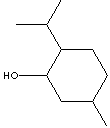PRODUCT IDENTIFICATION
89-78-1; 15356-70-4(racementhol), 2216-51-5; 98167-53-4(Levomenthol)

201-939-0; 239-388-3(racementhol), 218-690-9(Levomenthol)
H.S. CODE
2906.11.0000
TOXICITY
SMILES
CLASSIFICATION
Natural Product. Alcohol, Isoprenoid, Terpenoid, Insecticide, Flavors and Fragrances. Biochemical ex Plants. Antipruritic, Dermatologic
PHYSICAL AND CHEMICAL PROPERTIES
212 - 215 C
REFRACTIVE INDEX
95 C
GENERAL DESCRIPTION & EXTERNAL LINKS
Wikipedia Linking:http://en.wikipedia.org/wiki/Menthol
http://www.leffingwell.com/menthol1/menthol1.htm
|
|
|
|
India (natural) |
|
|
China (natural) |
|
|
Symrise (synthetic) |
|
|
Takasago (synthetic) |
|
|
Other synthetic* |
|
|
Brazil (natural)** |
|
|
Taiwan (natural)** |
|
|
Japan (natural)** |
|
|
Total |
19,170 |
|
*Other (synthetic) produced primarily from reduction of menthone ex Mentha
arvensis oil primarily from India - may possibly be blended into natural
menthol, in some cases. |
http://quimicanova.sbq.org.br
2-Isopropyl-5-methyl-cyclohexanol
(menthol) is a monoterpene, that has four stereoisomers: menthol,
isomenthol, neomenthol and neoisomenthol. In turn each of these
stereoisomers has two optic isomers (levogirous and dextrogirous
forms) yielding a total number of eight menthol isomers. These eight
optically active isomers have organoleptic differences between them.
(-)-Menthol is the isomer of highest commercial value due to its
highly refreshing action. It is widely used in the fragrance, pharmacy
and flavour industries and is the main component of the Arvensis
peppermint oil. This oil is the main natural source of menthol and
is recovered by steam distillation of the liquid contained in peppermint
leaves. (-)-Menthol is obtained from this recovered oil using a
low temperature crystallization process. This product is centrifuged
to remove the non-crystallizing liquid fraction and then the solid
fraction is dried at low temperatures. The whole process takes 25-30
days in a refrigerated chamber.....
Local:
GENERAL
DESCRIPTION OF CAMPHOR: Camphor is a white crystalline bicyclic saturated terpene ketone with a
characteristic pungent odor and taste,that is flammable and volatile; melting at
176 C, boiling at 204°C and specific gravity 0.992. It is insoluble in water
but soluble in alcohol, ether, chloroform, Benzene, carbon disulphide and other
solvents. Camphor was formerly obtained from the wood of the Taiwanese camphor
laurel tree (cinnamomum camphora), but now is synthesized from pinene which is
obtained by refining crude turpentine oil. It is used as a plasticizer in the
manufacture of celluloid film and some lacquers. It is used as an insect repellent
and in pyrotechnics. It provides cooling effect when applied to the skin. It is applied topically to the skin as
well as in pharmaceuticals as an antipruritic and anti-infective. It
is used for rubefacient preparations in medicine to relieve mild pain and
itching. Other rubefacients include benzyl nicotinate, methyl and ethyl
salicylate, glycol salicylate, methyl nicotinate, capsaicin and capsicum
oleoresin. Camphor is also an ingredient in cough remedies, ear drops, and
preparations for the removal of corns and verrucas. Camphor similar compounds
include:
Anethole (Anise Camphor): a white crystals anise oil similar odur; melting point 22.5 C; slightly soluble in water; light sensitive. It is btained from anise and fennel oils and other sources, or prepared synthetically. It is used in perfumes and flavors and as a flavoring agent for drugs. It is used as a sensitizer in color-bleaching processes in color photography.
Menthol (Peppermint Camphor): ) a white crystalline compound with a characteristic pungent odor; freely soluble in alcohols, ether, and chloroform. It is obtained from mint oils (mainly peppermint) or made synthetically from coal tar. It exists in levo or dextro isomer forms. Menthol imparts a tingling sensation to the skin and used in skin fresheners like after-shave and suntan lotions. It has a local anesthetic property for short-term relief of minor sore throat and minor muscle aches. It is used in medicines and perfumes, and as a mint flavoring agent. End applications include toothpaste, cough drops, ice cream, chewing gum, shampoo, medical plaster.
Thymol (Thyme Camphor): a white crystals with camphor like odor, is a phenolic compound obtained naturally from thyme oil (or other volatile oils) or prepared synthetically. It is very slightly soluble in water; soluble in paraffin oil and alcohol. It is used as a stabilizer in pharmaceutical and as a topical antiseptic, antibacterial, and anti-fungal agent. It is also used as a flavoring agent for drugs (camphor, herbal, wintergreen,disinfectants, origanum )
-49° ~ -50°
0.05% max
98.0% min
Hazard Symbols: n/a, Risk Phrases: 36/37/38, Safety Phrases: 24/25-28A-37-45
PRICE INFORMATION